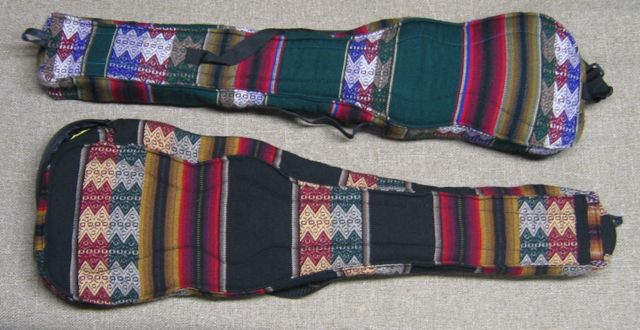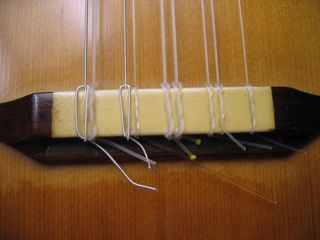
Charangos from Bolivia: Instruments For Sale (as of May 14, 2018)
As of May 14, 2018 I do not have any charangos for sale. I am out of the splendid Ignacio Suarez Professional Charangos. If I get any more good charangos I will post them on this website.
Since the 1993 I have acquired good charangos from Bolivia, below are photos of some charangos I have had for sale. I have played the charango for a long time so I know how to set-up the action and to judge what is a good instrument. At the foot of the page is some information on tourist grade and professional quality charangos.
See a hi-definition video in an unlisted section of YouTube about the 2 models of Ignacio Suarez Charangos. This video mentions old prices for the rosewood and ebony charangos. Since I made the vidoe prices have increased a few percent: https://www.youtube.com/watch?v=rALfcNUR9Nw
What is a Charango?
The charango is a Bolivian/Andean folk instrument which evolved from the 16th/17th century Spanish vihuela de mano. It looks like a small guitar but has 10 strings separated into 5 courses. Sometimes an armadillo shell is used for its soundbox--these are now hard to acquire because they require export permits from South American countries and import registration into the US under the Lacey Act of 2008. In South America, there are 2 types of armadillo used for making charangos, the Quirquincho (hairy armadillo) and the Tat Portugal (hairless armadillo). Excellent sounding instruments are also made of South American hardwoods. While the armadillo backed charangos are quite fascinating, many professional players say that the wooden charangos have a stronger sound.
There are 2 basic types of wooden charangos. One type of charango has a body shape like a guitar--it has a flat back and the sides are bend of thin pieces of wood just like a standard Spanish guitar--I do not sell that style of charango. The other type of charango features a body carved out of a solid block of wood and has a round back--this is the type of charango I sell.
The soundboard of charangos is typically made of a coniferous wood (i.e., it comes from a tree that has "pine cones"). Most of the charangos I get have a spruce soundboard, but good instruments can be made of many types of pine, redwood, western red cedar or similar South American species. The body is best made of a high density wood from a deciduous tree (i.e, a seed bearing tree), what is commonly call a "hardwood" species in English. I usually get charangos made of a golden orange colored wood which the Bolivians call naranjillo. According to Ernesto Cavour's book, El Charango (2001, published by Producciones Cima, La Paz,Bolivia, p. 63) some of the other woods used for charangos are: soto mara (madera rojo), laurel, najna, itichuriqui, chirimole, tarco, aitachi, sauco and moradillo. The fingerboard of good charangos are ebony, some species of "rosewood" (dalbergia spp) or other dense hardwood.
For me, a good charango has a very enchanting and complex sound. Rather than me struggling to describe what is sound like, I suggest that you go to YouTube and search for music and videos under "charango" and related terms.
Models of Charangos For Sale (May 14, 2018--out of stock). Solid spruce soundboard, naranjilla body. Real bone nut and saddle. The frets are properly place on these instrument so the intonation is correct. The string action is good so these instruments are not difficult to play. Here at Fernandez Music I check/improve the levelness of the frets, file the edges and polish the frets before I sell a charango (or any other fretted instrument).
As of May 14, 2018 I do not have any charangos for sale. I am out of the splendid Ignacio Suarez
Professional Charangos. If I get any moer good charangos I will post them on this website.

Cloth bags for Charangos made in Bolivia


Early 1990s Gamboa charango made in Bolivia, Armadillo body, private collection (not for sale)
About Tourist Grade Charangos
I (Ron Fernandez) have been playing the charango for over 30 years, it is one of my favorite instruments. When I travel I often take one with me to entertain myself. The first charango I acquired was in Mexico City in 1985--it was constructed by a maker who was originally from Paracho (Michoacan) Mexico--a colonial town where the locals were first taught to make musical instruments by the Catholic missionaries in the 16th century. This first Mexican charango was made of a species of hairless armadillo which lives in Mexico and the southern United States. This charango was adequate as beginner instrument but it did not have certain refinements which I later realized were necessary for a good professional charango.
Perhaps the most important was that this typical "tourist grade" charango did not have a saddle in the bridge. The strings were simply tied to the bridge without a bone saddle to rest on. The problem with such a system is that there is no exact point which marks the common length for all strings. My first charango is long gone so I cannot show a photo of the bridge however, You can see the problem of tying string to the bridge without a saddle in this photo of a bridge from an antique Baroque guitar. The problem is that the point at which the each string leaves the bridge can be a difference which is significant enough to cause problems with tuning. In the photo below the wound string on the left is tighter then the plain nylon string next to it--this means that these 2 strings of the same course have a different playing lengths. In essence, a "saddleless" bridge is difficult to tune because the sounding length of pairs of strings can be inconsistent.

Photo of string tied around a bridge which has no saddle. This is typical of some tourist charango. It was typical of guitar family instruments before the invention of the bridge saddle in the early 1800s.
The second problem with my "tourist grade" Mexican charango was that the neck angle was not good which resulted in high string action. The third thing was that the frets were not all level and the edges were slightly sharp because they protrude beyond the fingerboard. The fourth problem was that the fret were placed using an antiquated system for calculating fret placement called the rule of 18. Consequently the fret were not accurately placed for good intonation (The "rule of 18" was a system for calculating fret placement which was long used in Paracho--with this method the string length was divided by 18 and that number gave the size of the first fret, then the the remaining string length is divided by 18 to find the size of the next fret. Unfortunately, ther rule of 18 is not accurate enough for calculating fret placement and results in a 12th fret which is a few millimeters off. A more accurate number which can be used for calculation fret placement is 17.817.)
Often tourist grade charangos have brass colored fret--such frets do not less as long as better/harder frets. Good quality charangos have frets made of "nickel-silver", the same as are used on good classical guitar. I should mention here that "nickel-silver" does not contain any silver, it is looks somewhat like silver but contains cooper, nickel and zinc.
I tell the story about my first charango so the reader can be aware that there are various factors which determine the quality of charangos and so they are aware of some of the things to look for. What is a cheap price in the beginning often becomes a barrier to learning the instrument. If the instrument is difficult to play or to tune the beginner often gives up and sometimes thinks that learning an instrument is too difficult. Currently, in North America such tourist charangos might be found used for under a $100, in contrast, professional grade charangos are usually above $300.
For reasons mentioned above, I do not sell tourist grade charangos because I think that they are not good value.
In my opinion a good sounding, playable charango, what might me called a professional quality charango, should have a bridge with a saddle, silver-nickel frets, a neck angle so the strings are not too high, string height of 2 to 3mm at the 12th fret, properly calcuated fret placement, properly dried wood to prevent cracking of face or neck warping, spruce sound board (which is my favorite), ebony fingerboard for the best instruments, good hard rosewood is also acceptable for fingerboard but not dyed woods. Armadillo body instruments are very interetsing but as I have mentioned above there are restrictions on their exporation and importation. Bodies carved from a solid block of dried hardwood produces a strong, full, projecting sound. Golden color Naranjillo is an excellent wood for making charangos--it looks beautiful but also it seems to be a stable wood when dried. On a professional charango the frets should be properly seated in the fret board and the frets tops should be level and the top of the frets should be crowned (i.e., rounded), smoothed and polished. The edges of the frets should not feel sharp; fret edges protrubing past the edge of the fingerboard is an indication that the fingerboard has shunk which is a sign that the wood was probably not dried before the assembly of the charango. Ornamentation with shell, wood veneer, or mother of pearl or elaborate carving and painting usually suggests that the maker intented the particular instrument to be a higher priced instrument, nevertheless, excessive ornamentation sometimes may not justify a very high price. Sometimes the instruments with a "lot of pretty" stuff is just intend to attract tourists. My bottom line is: judge the charango on how well it plays and how good it sounds while still being aware of the level of materials, design and construction.
If you contact me by email,
please tell me where you are.
For information on charango string gauges, tuning, chord booklet and method books, press here
Return to Fernandez Music Home Page
Ronald Fernandez, Fernandez Music, P.O. Box 2130, Anacortes, Washington 98221. Phone: 949-856-1537